Icon, March 2012. Cover photograph: Bryan Allen. Source: Unknown Fields Division
In the March issue of Icon magazine, devoted to ruins, deputy editor Will Wiles files a report from the city of Pripyat in northern Ukraine. The name might not be instantly familiar, but everyone has heard of the nearby town of Chernobyl, site, in April 1986, of the world’s worst nuclear reactor disaster. Poisoned, deadly, uninhabitable and abandoned, the 19-mile exclusion zone around Chernobyl has become the Holy Grail — as one of Wiles’s interviewees puts it — for visitors who want the ultimate and most exclusive thrill available, with enormous difficulty, to urban explorers. Plans to open the zone to limited tourism in 2011 came to nothing, but Wiles got in on a tour organized by the Architectural Association in London’s irresistibly named Unknown Fields Division (sign me up now). Needless to say, a visit is still highly risky — contact with a stray particle of strontium or caesium could kill you eventually — and has to be tightly controlled.
It’s a fascinating read, though Icon’s pictures are a bit disappointing. No one can get too near to the “sarcophagus” enclosing the reactor and most of the scenes of flaking walls and scattered debris could be anywhere dilapidated. They do have a great picture showing how, in just a quarter of a century, the inexorable forest has burst through the fabric of the city and engulfed the empty buildings in greenery. But there is nothing to rival the many incredible and widely seen photographs taken of the urban devastation in Detroit.
It’s extraordinary, to someone who doesn’t live in Detroit or elsewhere in America, how contentious those pictures have become. They are the prime, disreputable exhibits of so-called “ruin porn,” a term widely used now in the US, though not as yet much in evidence in the UK. I dislike the coinage intensely and I’m not surprised that thoughtful, well-intentioned photographers are annoyed to be smeared with it. Ruin porn is a corrosively repeatable meme that makes any picture of ruins seem suspect. In an essay for Places, Jerry Herron suggests that pictures like those by Yves Marchand and Romain Meffre in The Ruins of Detroit (showing at Wilmotte Gallery in London, February 24 to April 5) foreclose action, “except for the connoisseur-like contemplations of the solitary spectator, who is freed to look at the worst, without any necessity of further exertion.”
You could say that about anyone looking at any kind of picture at a remove from a scene or event. The moralism is misplaced because it hinges on an impossibly utopian notion of how viewers, and seemingly all viewers, could respond to an image. What exertions does Herron expect of those who viewed Marchand and Meffre’s pictures with horrified amazement in, for instance, a British newspaper, which is where I first encountered them? (I had already visited Detroit several times and seen the decay.) If inaction when confronted with the ocean of pictures is truly a problem, then the real complaint is with human nature, with politics, with the media, with life, and not, uniquely, with pictures of ruins. Meanwhile, plenty of people with a good reason to act will continue to find ways to act with or without the encouragement of photos.
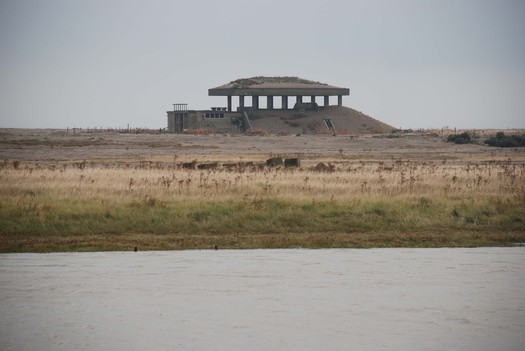
Laboratory 4, Orford Ness, Suffolk, 2007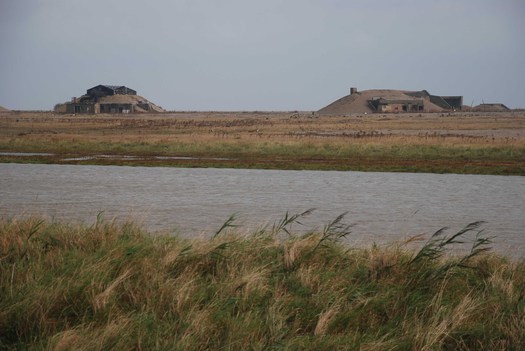
Laboratory 1 and Laboratory 3, Orford Ness, Suffolk, 2007
If pictures of ruins are ruin porn, then presumably visiting actual ruins is ruin sex (see how stupid this metaphor is). I know which I would rather do. And Chernobyl must be a mind-blower. Not having had that pleasure, I’m showing here some pictures I took at Orford Ness, a long shingle spit on the Suffolk coast in Britain that was formerly used for secret weapons testing by the Ministry of Defence and is now a nature reserve. The ruins of the laboratories have been allowed to stand, with the assumption that they will gradually decline, and several cannot be visited without a guide, but you can get some way into Laboratory 1 on your own. The spit is highly exposed to the elements; the site can only be reached by a small ferry and on the day I visited with a friend, the place was deserted. The sky was overcast, a cold wind blew, rain lashed down, we were soaked the whole time, and moisture got into my camera lens. It certainly added to the atmosphere of the pictures. I thought of Laboratory 1 again this week while reading Geoff Dyer’s Zona, a book about Tarkovsky’s film Stalker, in which a guide, Stalker, takes two men, Writer and Professor, into a damp, ruinous former industrial zone in search of a mysterious room in which their wishes will be fulfilled. Spookily, the 1979 film seems to prophesy the Chernobyl exclusion zone.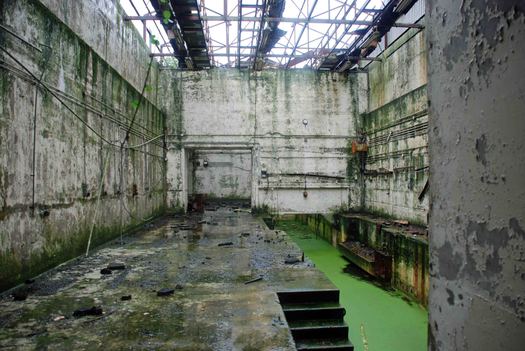
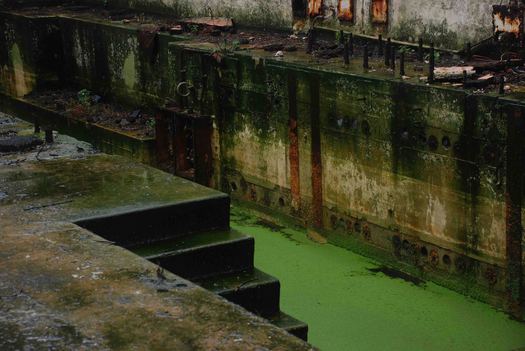
Laboratory 1, Orford Ness, Suffolk, 2007
The curious thing about American disapproval of “aestheticized” pictures of ruins is that it seems ahistorical. Perhaps the US, as a younger country, is just less used to the presence and idea of ruins. Maybe ruins, as signs of thwarted hopes and failure, offend deeply against national positivity so that photographing them, appearing to enjoy what the pictures show, is felt to be in horrible bad taste. Hard to know: I don’t feel that way. Where I come from, a childhood trip in the family car at the weekend to look at a half-ruined castle or monastery was almost routine. Europe is littered with lovely ruins. There is a tradition, many centuries long, of visiting them, admiring them, musing on them, and depicting them.
Christopher Woodward’s In Ruins (2001) is a wonderfully written account of art history and literature’s relationship with the ruin, from Gustave Doré’s New Zealander of 1872 contemplating the crumbling edifices of a future London to John Piper’s Second World War paintings of bomb-damaged Coventry and Bath (Woodward also discusses W.G. Sebald’s visit to Orford Ness in The Rings of Saturn). Brian Dillon’s new book Ruins, in the excellent Documents of Contemporary Art series, has 20th-century texts on our complex reactions to ruins by Georg Simmel, Walter Benjamin (The Arcades Project) and Rose Macaulay (Pleasure of Ruins, 1953). The reductive “ruin porn” tag ignores the cultural history of the ruin, along with its deeper philosophical dimensions. (I’d better hasten to make it clear, though, that I’m not suggesting that Detroit’s condition isn’t alarming, or that it shouldn’t be understood as evidence of political and economic misdirection. Clearly it should.)

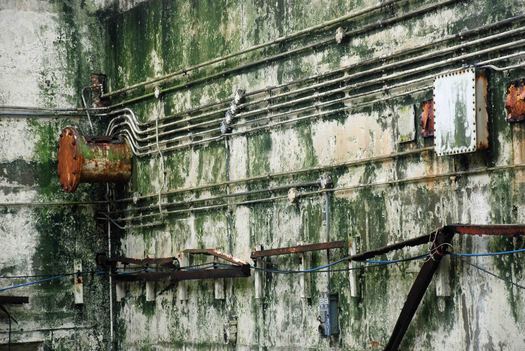
Laboratory 1, Orford Ness, Suffolk, 2007
Nevertheless, there are many reasons to be fascinated by ruins. For me, this attraction is first of all about being in the place. (Photos of ruins function in the same way that all kinds of photos function: they fire the imagination and provoke a desire to see for yourself.) The idea that best explains my love of ruins is the quest for re-enchantment. The abandoned ruin is a special zone charged with an intensity and a potential for revelation that most ordinary, complete and comfortable places lack. The more corporate daily experience becomes, the more some sites of ruination can offer an interlude of release into a refuge that is not accessible to crowds (it may well be unsafe), not overseen by officialdom, and not commercialized. Some regard these fractured spaces as being loaded with radical and even utopian potential. I know I have felt moments of inner peace, elation and great possibility in these supposedly melancholy places; I have also experienced enough to admit that risk is a keen part of the pleasure. Walking on the Great Wall of China, I came to the end of the maintained, official concourse. No one was around to stop me — there was no one around at all — so I ignored the danger sign, climbed over the half-hearted barrier, and kept on going in the immense silence above the landscape along the top of the unrepaired wall.
Photographs: Rick Poynor
See also:
On My Screen: Bill Morrison’s Decasia
